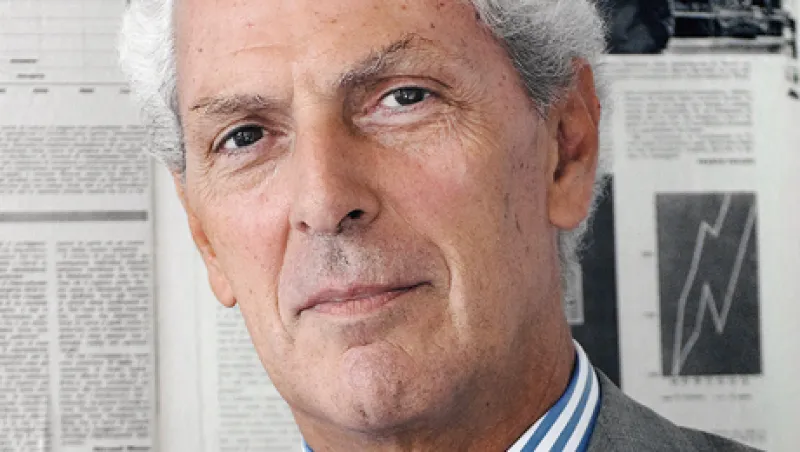In the boardrooms of Italian industry, few have had as long and colorful a career as Marco Tronchetti Provera. In his two decades at the helm of Pirelli & C., the 64-year-old executive transformed the Italian manufacturer from a tire maker to a diversified conglomerate that controlled the national telephone company before reverting to its core business over the past five years. Pirelli now generates 99 percent of its revenue from tires, having sold off its interests in real estate and broadband last year.
In addition to sharpening the group’s focus, Tronchetti has pulled off an even more impressive feat: He has made Pirelli, an icon of Italian industry, relatively immune to the financial turmoil gripping Italy and the euro area. Over the past half dozen or so years, Pirelli has invested heavily to build up its presence in North America and in fast-growing markets in Asia, the Middle East and Latin America. Today the company operates 22 plants in 13 countries around the world, including facilities that started production this year in Mexico, to supply the North American market, and in Russia, where Pirelli has launched a joint venture with local partners. The company is also entering Indonesia with plans to make motorbike tires.
Pirelli may embody Italian style and engineering flair, but it generates less than 10 percent of its revenue in its domestic market and just over 40 percent in all of Europe. North America, Asia-Pacific and the Middle East and Africa contribute about 30 percent of revenue and grew at a double-digit pace in the first quarter of this year. South America, which represents 30 percent of the business, grew revenue at a 7 percent clip in the quarter, compared with just 3 percent growth in Europe.
The company is also going determinedly upmarket — appropriately for a business that returned as the sole supplier to the Formula 1 racing circuit last year after a 20-year absence. Milan-based Pirelli is putting most of its resources into premium-performance tires for luxury vehicles and sports cars, which command roughly twice the price and offer triple the profit margins as standard tires, which the group is deemphasizing or phasing out. Thanks to that high-end accent, the company expects to boost revenue by 14 percent this year, to €6.45 billion ($8.17 billion), even as tire shipments drop by 1 to 2 percent in volume. Pirelli posted a 54 percent gain in net income in the first quarter, to €125.3 million; revenue rose 11.1 percent, to €1.56 billion.
Tronchetti may be making Pirelli more global, but even he can’t divorce the company’s fate from that of Europe and the euro. With much of Europe back in recession and yields climbing on Italian debt, Pirelli is feeling the squeeze. In May the company trimmed its revenue forecast by 3 percentage points. Europe’s political leaders need to take urgent action to save the euro and the European economy, Tronchetti warns. He met recently with Institutional Investor International Editor Tom Buerkle to discuss the outlook for Pirelli and the euro.
Institutional Investor: Pirelli is now as pure a play, on tires, as it’s ever been. Why is that a strength?
Tronchetti: In today’s world it’s a must to be focused. The business where Pirelli is focused, the premium tire segment, is very exciting because it’s growing in all regions of the world. It is more and more technologically driven. Today’s tires have little to do with the tires of 20 years ago except they are round and black. The technology, starting from the compound, going to the structure of the tires and also to the service we provide — it’s a different business. And it’s a business that is less cyclical than the automotive industry because only 25 percent of Pirelli’s sales are related to original equipment; 75 percent is related to consumers. If you don’t buy a new car, you in any case have to change your tires.
How hard is it to run a business in Italy these days?
Let’s say that we face a need to reshape our business in Italy. We shut down an old plant that was producing standard tires, and we set up the most advanced plant in our tire business worldwide. We have agreement with universities to evolve the technology. But Italy today represents only 7 percent of our production and turnover. In the past few years, we’ve reduced the weight of Europe.
What’s driving your growth strategy in rapidly developing economies?
In the past five to six years, we went to China and Romania. One year ago we went to Mexico. This year we went to Russia. This is the evolution of the company. The driver of all of this is to be in regions where there is an opportunity for technologically advanced products, and focusing on the car manufacturers that are asking for technology. That is why we set up these new plants. Mexico is to supply Nafta [North American Free Trade Agreement countries]; Romania and Italy are to supply Europe, together with Germany and the U.K. Turkey is to supply the Middle East and North Africa; Russia for Russia and CIS countries and Scandinavian countries; and China for China and the Asian region.
Do all Italian companies have to become more global to survive?
I think the key issue is technology. Any industry that is based in the Western world has to focus on technology and the education of the management. When you have technology, you have to go around the world. You cannot stay and develop your market only locally.
Why are you confident that the premium tire segment will continue to gain market share?
We are not targeting market share. We have 5 percent of the global tire market but 12 percent in the premium segment. Premium is growing much faster than the standard segment. We are also a leader in the prestige segment [for superluxury models like Ferraris and Lamborghinis], where we have 50 percent of the market.
We’re going to launch 18 new product platforms — winter tires, SUV tires, high-speed tires, green tires — in the next five years. In the past decade we launched 16, so we are doubling our speed of evolution.
You have increased prices well ahead of the market and inflation. How sustainable is that?
When you sell technology, price is not such a huge issue. The value of the tires is between 1 and 2 percent of the value of the car. Safety, environment, consumption are very much related to the tires. With a standard tire, it’s much more price that is the driver of the willingness to buy.
What makes your position so immune to competitive pressures?
Our competitors have the same problem we have. We continue to grow. We need to make investments. They are playing the same game. They have to protect their cash flow, protect their investments. These are companies that have made huge investments to be global, and they cannot afford any attempt to take market share on price. You cannot get 1 point of market share in the high end if you fight on prices. Anybody is ready to fight against you. That’s what happened in the ’90s, when there was a war in prices. The result was that no one won 1 point of market share, and the industry was really stressed and loss-making. And then suddenly prices went up 30 percent. That’s nonsense. We want the value of our technology, and that’s it.
What’s your outlook for Brazil, where you have more plants than in any other country?
Yes, we have five plants. We are No. 1 in Latin America, with 25 percent of the market. The growth rate has decreased in Brazil, but the country is young, and we are confident it will continue to grow. It’s much more stable today than it used to be, 20 years ago.
What is your strategy for getting the most out of the Chinese market?
We have a large compound where we have passenger car tire and truck tire production. We fit directly in the premium segment of the market. We have a factory that is supplying BMW, Audi, Mercedes and Volvo; they are starting their production in China. And then we serve from China markets in Australia, Japan, Singapore and Hong Kong. They are growing fast. In Asia we sell 4.5 million tires a year. We are going to double the capacity in the next four years — double and more.
You have talked about a rise in protectionism. How does this affect Pirelli?
There are two effects. One is protectionism, and the other one is the volatility of currencies. So we will be more local-for-local regionally. That means for the Nafta market we will produce local-for-local in Mexico and in Rome, Georgia. Globally, we will be 82 percent local-for-local production by 2015, up from 71 percent today.
That flies in the face of what most people understand globalization to be. Does it make sense?
That is one of the facts of globalization. The different regions of the world are larger, but within these larger regions the economic cycles are faster, and so any region tries to protect its own employment, its own economy. And currency volatility creates a danger for the industry if you are not local-for-local. When we invest in a factory, we invest for the next decade. We cannot take the exchange rate risk for our people, for our products. So the more we are local, the more we reduce the risk.
That brings us back to Europe. Europe created a single currency to get rid of volatility; now some people say we might not see the euro in ten years’ time. What’s your view?
I think the euro was a very serious intuition of the founders. The founders suffered the experience of two world wars. They understood only a united Europe could make it possible to come to an end of these tragedies. They first set up CECA, the coal and steel community, based on the two materials that were the precondition of the war. Then they created a single market. Then Europe forgot the origins of the union. We created a single currency without a political union, which is something that cannot last forever. You have a common currency without a common policy. It’s not sustainable.
Are you confident that European leaders will fix the problem?
It’s a must. Otherwise it will be a tragedy. I think the agreement reached at the end of June was a first step toward a real European unification, both political and economic. We hope that the rest of Europe, including Germany, is coming to realize that a solution that enables the euro to survive is in everyone’s interest.
How much time do you think they have?
Months. I don’t think they can face the elections in Germany [in 2013] without having solved the issue. It’s true that many European countries lived beyond their means. It’s also true that this helped provide a large market for the Germans and for everybody. Now it’s time to tell the people we are trying to put something together positive. We have a common aim, a common target. That was the spirit of the ’50s. We have to understand that we have to avoid tragedies. • •






